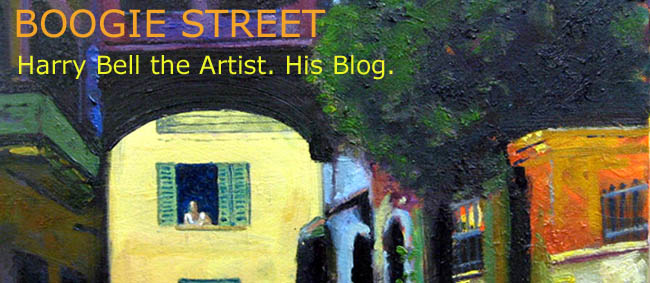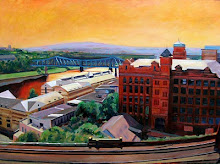
Theatre Royal, Grey Street (Private Collection)
Grey Street is one of the finest in Newcastle, designed by John Dobson in the Georgian style and apparently voted 'Best street in the UK' in 2002 by BBC Radio 4 listeners. I've always thought that it would be a suitable site for a good commercial gallery, so I was pleased to see earlier this year that a new gallery was opening there.
Alas, it's not what I was hoping for. Obviously, from a personal point of view, I would have liked them to be interested in local artists, but this has proven not to be the case. They're a branch of a national chain with Rolf Harris as their Big Name.
What depresses me most, however, is the fact that most of their stock is what they like to call limited edition prints, but which we know to be reproductions. I know this is something of a lost battle, but it's worth making the point now and again. The spin they put on these reproductions is one I've not previously come across. They're what they term hand-embellished. Looking at them, it's obvious that they're simply reproductions on which a few flicks of paint have been added. In a number of cases, they've had a transparent resin brushed onto them so that the effect of impasto is achieved without adding any extra colour whatsoever.
Although I thought this was pretty feeble, I did get the impression that the artists had done the additions themselves. However, I've come across this in some of their literature:
Grey Street is one of the finest in Newcastle, designed by John Dobson in the Georgian style and apparently voted 'Best street in the UK' in 2002 by BBC Radio 4 listeners. I've always thought that it would be a suitable site for a good commercial gallery, so I was pleased to see earlier this year that a new gallery was opening there.
Alas, it's not what I was hoping for. Obviously, from a personal point of view, I would have liked them to be interested in local artists, but this has proven not to be the case. They're a branch of a national chain with Rolf Harris as their Big Name.
What depresses me most, however, is the fact that most of their stock is what they like to call limited edition prints, but which we know to be reproductions. I know this is something of a lost battle, but it's worth making the point now and again. The spin they put on these reproductions is one I've not previously come across. They're what they term hand-embellished. Looking at them, it's obvious that they're simply reproductions on which a few flicks of paint have been added. In a number of cases, they've had a transparent resin brushed onto them so that the effect of impasto is achieved without adding any extra colour whatsoever.
Although I thought this was pretty feeble, I did get the impression that the artists had done the additions themselves. However, I've come across this in some of their literature:
An increasing number of our Limited Edition Fine Art Prints are now hand-embellished.
This means that the print is placed alongside the original and under the direction of the artist certain elements of the image are highlighted with paint, inks, varnish or other medium by a master craftsman. This is done to bring each piece closer to the essence of the original and adds a new layer of authenticity to the finished composition. It also transforms each print into a unique handmade piece in its own right.
A "master craftsman", eh? Not even the artist. What a farce.












11 comments:
Harry, I'm glad you have talked about these so-called limited edition prints, aka reproductions. I've mentioned it on my blog in the past too. As a printmaker, I find this practice to be deceitful, taking advantage of uninformed buyers. What I find almost more appalling is that there are well-known artists who are already selling their paintings at high prices, who have their paintings reproduced and they sign them as if they are originals. These are also sold at high prices even though they are reproductions, and the buyers have been swindled! Original prints, such as I and other printmakers make, are having a hard time competing against these reproductions when certain groups of both dealers and artists confuse buyers. I've actually had to defend my work as being original to some who mistrust prints!
Again, thanks for posting this. We really need to make the public aware of this practice.
I'm very happy to lend you my support in this, Marja-Leena.
giclee, Harry? I worked with an art dealer for a short time when these were first coming in some years ago.
His opinion then was that people still preferred the originals - but don't know if that is the case now.
Thanks for your comment earlier.Hope to post some art on this blog as and when.
I've got to think about this a bit more. I immediately take your points as artists about original work and artistic integrity. But may I ask a few questions?
Are buyers REALLY so naive or blase that they think that, or don't care if a signature signals an original? Is this trend perhaps to do with a wish for personalisation - as in getting an actor's signature on a theatre programme? If so, the buyer has complimented the artist?
Is it all about money? Do the prices of signed repro's generally reflect their lesser status? I don't know this. Are we talking about greedy artists here, or are artists being exploited by dealers? If artists are involved, how can you reproach them - it's their work, their choice?
If the stated provenance and price differential between the two are honest, does a signed reproduction now compromise the monetary or artistic value of the originals?
That truly is appalling, and not something I've encountered yet.
Thanks fo posting.
I've just been for a roam round your blog - it's truly fascinating, I love your stuff and you seem to get some great video clips - all the way through I was thinking, this sounds like an early Maria Callas and was entranced by the artwork of, er, tried going back to look up his name and can't find it. It was foreign. I loved the chunky ballerinas and animals, quite sensual all that delicate flesh and fur!
Can't you complain to the gallery that's just opened about not showing local artists' work? Regarding prints, if people want prints are they likely to mistake a print for an original - even if they are added to - trade descriptions act and all that - a print's a print.
--Simone
tide turn -- I realise that giclees have established themselves, Julie, and as long as people are aware that they're only reproductions, I don't see the harm. The difficulty arises when the public at large are led to believe that they are in some way a "special edition."
Anna -- I honestly think that the majority of the public (a t least in the north east) are clueless when it comes to the difference between an original print and a reproduction. Unfortunately, I also think that most don't care. If it looks good on the wall, or goes with the curtains, and it's affordable, that's OK.
I do think artists are being exploited, but they're colluding in their own exploitation. It's difficult ewnough to make a living in the art world, so if a publisher wants to sell copies of your work, that's going to help out. When, for instance, the copy takes the form of a greetings card, no one is under the delusion that it's anoriginal work of art. But when it's printed onto canvas, and even has some tacky bits of gunge added to the surface (by a master craftsman, no less!), and then is numbered and signed by the artist, i think the public is being misled. But one of the artists in the gallery I spoke of was a Past President of a prestigious national painters organisation, so what do I know?
I do know that in the last few days I've been invited to put my money where my mouth is, which is going to take some thinking about. More on that as it develops.
Simone -- Ilya Zomb is the artist you're trying to remember. It's the signing and numbering of reproductions that leads the public to think they're getting something that's different from the usual reproduction and must therefore be "special".
Beatiful light captured in this piece.
Thanks, Seth.
Harry, you're so right about most of the general public not knowing the difference between fine art limited edition prints and mass-produced prints. It's not just Newcastle. Curators in museums and art galleries up and down the country tell me stories of people coming in to seek an opinion on a work of art, ask their advice about repairs etc, and even think that a print is a painting. One even thought that their print of a famous Constable painting was a real Constable painting.
What is ironic and sad is that they probably will pay as much for a mass-produced print as they could for a unique and good piece of art. I think it might be 1) because such prints are sold in a way to make them feel they're in a posh but quite comfortably familiar environment; 2) are reassured that they are buying something that is acceptable, a safe aesthetic choice that won't make them look stupid in front of their friends; 3) it must be good value because the shop/gallery tells them it is.
Unfortunately, I'm sure you're absolutely right, Janet. It doesn't refelct well on part of the gallery trade.
Post a Comment